Lincoln Wheat pennies have been minted for over 110 years, and that long lifespan means plenty of variety and collectibility, especially for older coins like the 1950 Wheat penny. These older cents are more appealing to collectors, not just because of their age, but also because of the differences in mint marks, preservation, and potential errors or damage.
When determining the value of a 1950 Wheat penny, the key factors to consider include:
- Condition (grade) – Coins are more valuable in higher grades with fewer signs of wear.
- Color – Red coins (RD) are more valuable than red-brown (RB) or brown (BN).
- Mint mark – Coins from Denver (“D”) and San Francisco (“S”) can have different values than those from Philadelphia (no mint mark).
- Strike type – Proof coins were only minted in Philadelphia and carry a premium.
1950 Wheat Penny Value Chart (Red coins only)
| Condition | 1950 (P) | 1950 D | 1950 S |
|---|---|---|---|
| MS 60 | $2 | $3 | $2 |
| MS 61 | $2 | $4 | $2 |
| MS 62 | $2 | $5 | $3 |
| MS 63 | $2 | $8 | $7 |
| MS 64 | $14 | $14 | $15 |
| MS 65 | $26 | $20 | $20 |
| PR 63 | $55 | – | – |
These values assume red (RD) designation, meaning at least 95% of the original red copper luster remains.
History of the 1950 Wheat Penny
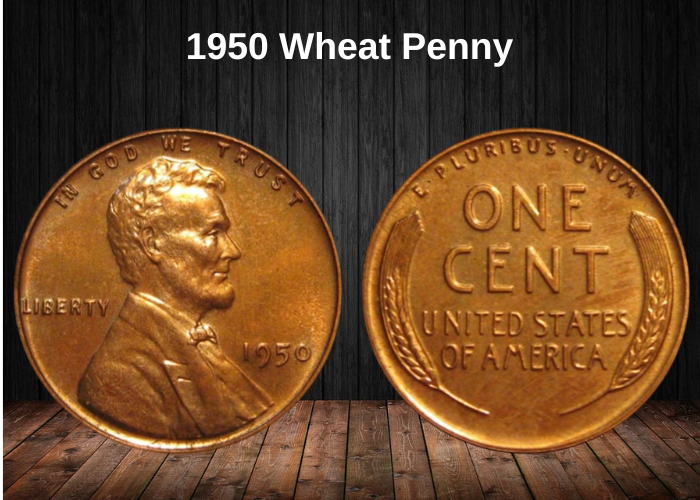
The Wheat pennies hold a special place in U.S. coinage history, not only because of their long production run but also because of the significant cultural shift they represent. First issued in 1909, these coins marked a turning point in American numismatics by featuring the first real person on U.S. currency: President Abraham Lincoln.
🇺🇸 A Symbol of Change
Before 1909, American coins featured allegorical figures like Lady Liberty, as a way to avoid the monarchical tradition of placing leaders’ faces on currency. That practice reflected George Washington’s belief that using actual individuals on coins felt too much like European monarchy.
But in the early 20th century, President Theodore Roosevelt wanted to transform American coinage into “small works of art.” He also believed that Lincoln, one of the most respected U.S. presidents, deserved to be honored on currency—especially with the centennial of Lincoln’s birth approaching.
That led to the iconic design by Victor David Brenner, a Lithuanian immigrant and accomplished engraver. His portrait of Lincoln on the obverse (heads side) of the Wheat penny has become one of the most enduring in U.S. numismatics.
1950 Wheat Penny Types and Mintage
| Location | Type | Mintage |
|---|---|---|
| Philadelphia | 1950 (no mint mark) | 272,635,000 |
| Philadelphia | 1950 Proof Penny | 51,386 |
| Denver | 1950 D Penny | 334,950,000 |
| San Francisco | 1950 S Penny | 118,505,000 |
| Total | – | 726,141,386 |
These massive production numbers make most 1950 Wheat pennies fairly common, especially in circulated condition. However, proof coins and high-grade mint state examples (especially red ones) still attract strong collector interest.
Features of the 1950 Wheat Penny
The obverse of the 1950 penny

The obverse design of the Lincoln penny has remained virtually unchanged since its debut in 1909. It features a prominent bust of Abraham Lincoln facing to the right.
The motto IN GOD WE TRUST is inscribed along the upper edge above his portrait. To the left of Lincoln is the word LIBERTY, while the minting year appears at the bottom right. If the penny was struck in Denver or San Francisco, a “D” or “S” mint mark will appear just below the date.
The reverse of the 1950 penny
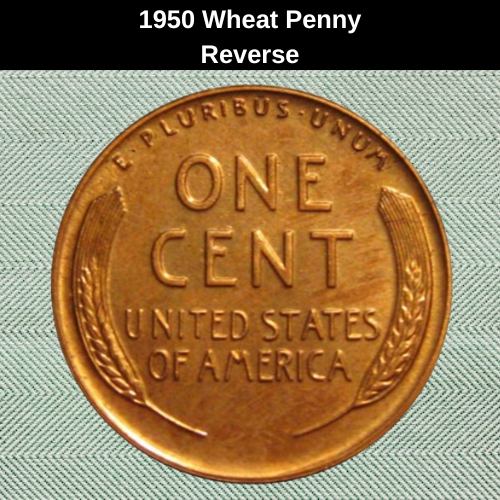
The reverse design of this coin is what gives it the nickname “Wheat penny.” It features two wheat stalks curving along the left and right edges. At the top, along the rim, is the Latin motto E PLURIBUS UNUM. In the center, you’ll find two inscriptions: the denomination ONE CENT at the top, and UNITED STATES OF AMERICA directly beneath it.
1950 Wheat Penny Specifications
- Face Value: One cent ($0.01)
- Weight: 0.11 ounces (3.11 grams)
- Shape: Round
- Composition: 95% copper alloy
- Diameter: 0.75 inches (19.05 mm)
- Edge: Plain (no reeding)
- Thickness: 0.06 inches (1.52 mm)
Additional Characteristics of the 1950 Penny
The 1950 Wheat penny is made of a 95% copper alloy, combined with zinc and tin. Like others in the series, it has a standard thickness of 0.06 inches (1.52 mm). Its weight of 0.11 ounces (3.11 grams) and diameter of 0.75 inches (19.05 mm) are also consistent with other Lincoln pennies from the same era.
1950 Wheat Penny Grading
To determine a 1950 Wheat penny’s condition and value, it’s important to evaluate its grade. This process is best handled by certified professionals, especially if you believe your coin may be valuable. Experts assess each coin’s details, looking closely for signs of wear, surface damage, or any breaks and cracks.
Here’s a general grading scale:
| # | Grade |
|---|---|
| 1 | Basal State-1 |
| 2 | Fair |
| 3 | Very Fair |
| 4–6 | Good |
| 7–10 | Very Good |
| 12, 15 | Fine |
| 20, 30 | Very Fine |
| 40 | Extremely Fine |
| 50 | About Uncirculated |
| 60 | Mint State |
| 65 | Mint State |
| 70 | Mint State |
Be sure to consult our grading guides to accurately identify your coin’s scale—this is an essential step in determining its true market value.
1950 Wheat Penny Value Guides
1950 No Mint Mark Wheat penny Value
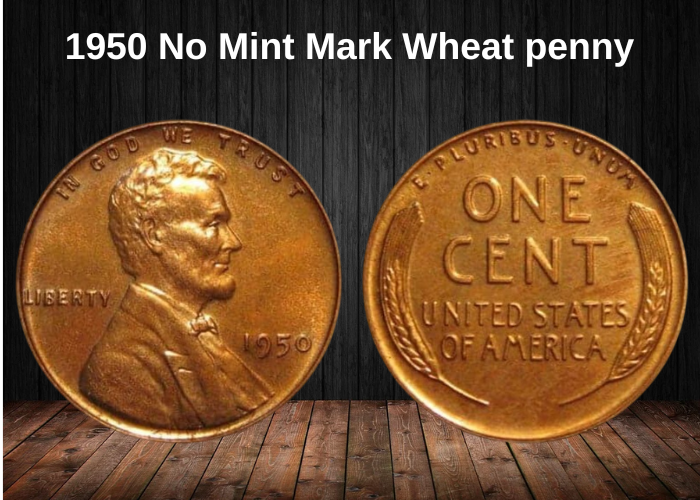
Due to the large mintage of 272,635,000 pennies struck in Philadelphia, the value of these coins remains relatively low. Additionally, coins without mint marks are quite common and easily accessible on the market.
Circulated brown pennies are typically valued between $0.03 and $0.07, and even those in mint state (up to MS64) can be found for under a dollar.
Red-brown pennies tend to be a bit more expensive. Coins graded MS63 to MS66 generally range from $0.35 to $15. However, high-grade MS67 examples will cost between $45 and $55.
Red pennies, as always, command the highest prices. For those graded MS63 to MS66, expect prices between $5 and $120. Coins graded MS67 can reach as much as $1,200. The most expensive 1950 Philadelphia penny was graded MS67+, and one collector paid an impressive $10,575 for it at an auction in 2020.
1950 Wheat penny (proof) Value
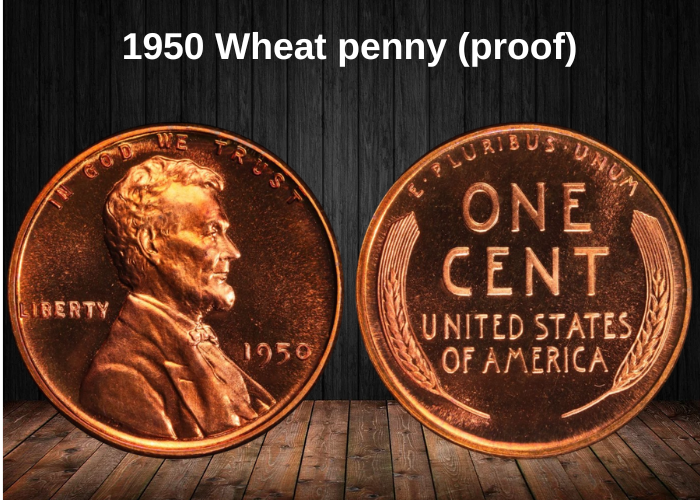
The Philadelphia mint struck 51,386 proofs of the 1950 penny, and their value differs significantly from regular coins. Here’s the breakdown:
- Brown proofs graded PR 60 to PR 66 are valued between $23 and $60, while those with a PR 67 rating cost between $200 and $230.
- Red-brown proofs are slightly more expensive, with PR 60 to PR 66 specimens costing $22 to $100, and those with a PR 67 rating reaching $150.
- Red 1950 pennies are the most valuable, particularly those with CAM (Cameo) and DCAM (Deep Cameo) contrast. These graded up to PR 66 are worth $525, while those rated PR 67 can cost $1200.
- The most expensive in the series is the PR 68-graded red 1950 penny, which can fetch $7,500.
For RD CAM (Red Cameo) pennies, prices vary based on quality:
- PR 64 – $135
- PR 65 – $225
- PR 66 – $525
- PR 67 – $1200
- PR 68 – $7500
And for red DCAM (Red Deep Cameo) pennies, the prices are:
- PR 64 – $275
- PR 65 – $650
- PR 66 – $1650
- PR 67 – $6500
The most expensive proof from 1950 was a red DCAM penny graded PR 68, which sold for a staggering $19,975 at an auction in 2017.
1950 D Wheat penny Value
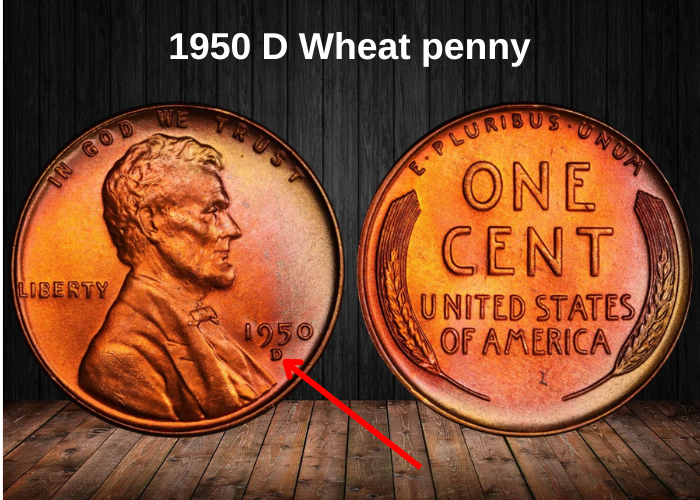
The Denver mint struck the largest mintage of 334,950,000 pennies in 1950, which resulted in their relatively low value due to the high circulation. Here’s the breakdown:
- Brown coins from circulation are priced at $0.02 to $0.07.
- Uncirculated pieces typically range in value from $0.10 to $9.60, while those with an MS 67 grade cost around $35 to $45.
For red-brown Denver coins:
- Prices range from $0.35 to $15.
- The highest-graded pieces (MS 67) are priced between $45 and $55.
For red 1950 D Wheat pennies:
- They typically cost $2 to $40.
- The most expensive pieces, those graded MS 67, are worth about $925.
1950 S Wheat penny Value
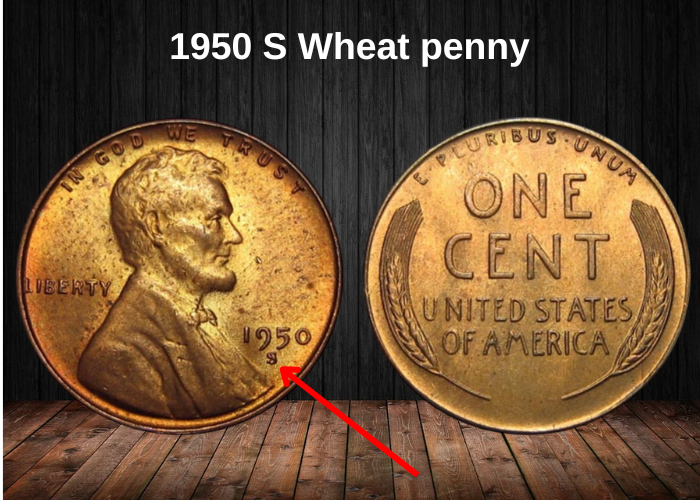
The San Francisco mint struck the lowest mintage of 1950 pennies, with only 118,505,000 coins bearing the S mint mark. However, this low mintage doesn’t significantly increase their value in the market.
- Brown coins from circulation are worth $0.03 to $0.24.
- Mint state coins range in price from $0.25 to $12, with MS 67 specimens priced between $37 to $47.
For red-brown cents:
- Prices for grades MS 63 to MS 66 range from $0.65 to $17.
- The highest-graded (MS 67) pieces are worth $47 to $57.
For red specimens:
- Prices for MS 63 to MS 66 range from $0.85 to $30.
- MS 67 red pennies typically cost $260 to $350.
- The record auction price for a 1950 S MS 68 red penny is $10,800 (set in 2021).
Rare 1950 Wheat Penny Errors List
BIE
The BIE mint error is a distinctive feature found exclusively on Lincoln cents, caused by a die break. It appears in the word LIBERTY, specifically between the letters B and E. The die break creates a longitudinal raised mark that resembles the letter I. This error can significantly increase the value of affected coins, with some being worth around $10 depending on their condition and grade.
Broad strike
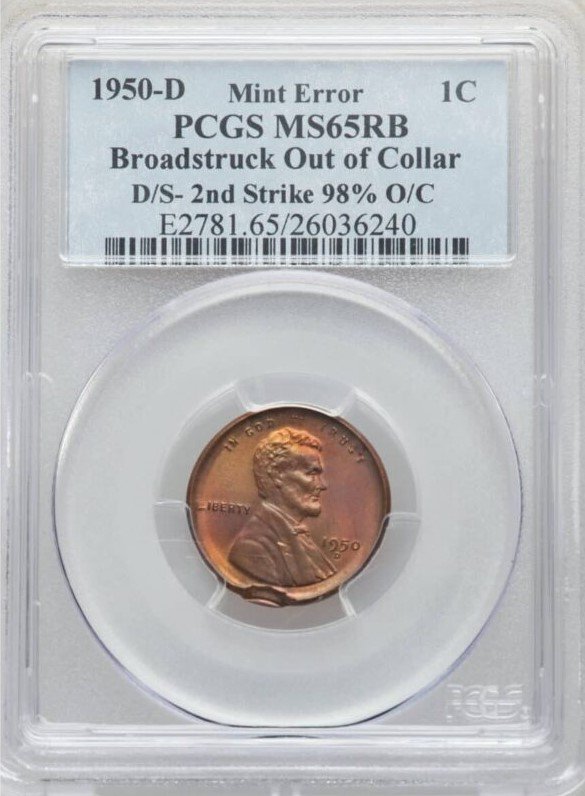
A penny with this type of error occurs when the collar holding the planchet (the blank metal disk) in place breaks during the minting process. This malfunction results in parts of the design being missing from the coin. These off-center errors can vary in severity, with some showing a larger portion of the design missing, and others displaying only slight misalignment.
The value of such coins depends on the appearance and size of the error. You can typically find these off-center error coins priced between $5 and $100, depending on the degree of the error and the coin’s condition. The rarer and more pronounced the error, the higher the value.
Off-center
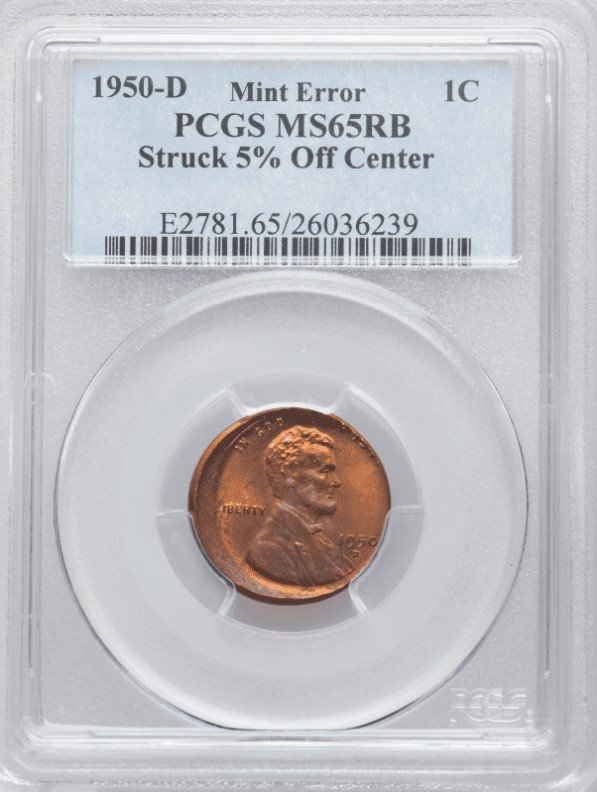
The off-center error occurs when a penny is irregularly struck during minting, resulting in a crescent-shaped defect instead of the full, expected design. The value of these coins depends largely on the percentage of the design that’s missing.
- Value is higher for coins with a larger missing design—the closer the defect is to 60% of the design, the more valuable the coin.
- Minting date and mint mark must be clearly visible for the coin to retain higher value.
For a 1950 off-center error penny, the value can go up to $300, especially if the error is significant, the mint date is legible, and the coin is in good condition.
DDO
The double die error is one of the most common and well-known errors found on pennies. It occurs when there is doubling of the design on the die, usually due to misalignment during the die creation process.
For 1950 Wheat pennies with this double die error, the value typically ranges from $3 to $120, depending on factors like the extent of the doubling, the coin’s condition, and the overall quality of the strike.
Where to sell your penny?
Now that you know the value of your penny, you might be wondering where to sell it. Don’t worry: here’s a guide to some of the best online platforms where you can easily sell your coins, along with their advantages and disadvantages.
Discover the best platforms for selling coins online (pros and cons).
FAQ about the 1950 Wheat Penny
1. Why is the 1950 Wheat Penny significant in U.S. coinage history?
The 1950 Wheat Penny is historically important because it is one of the last coins to feature the Wheat reverse design, marking the final years before the transition to the Lincoln Memorial reverse design in 1959. The 1950 penny represents a period of transition in U.S. coinage history, with the Wheat reverse being replaced after over four decades of use. As such, it is a significant piece in the Wheat series for collectors.
2. What is the metal composition of the 1950 Wheat Penny?
The 1950 Wheat Penny is made from:
- 95% copper
- 5% zinc
This composition was used for U.S. pennies from 1909 until 1942, and then again from 1944 to 1958. It’s part of the standard metal alloy that was common in U.S. pennies before the transition to the copper-plated zinc alloy used in 1962.
3. How many 1950 Wheat Pennies were minted?
The 1950 Wheat Penny had a large mintage, though it was not as high as some earlier years:
- Philadelphia (no mintmark): 1,082,228,000
- Denver (D): 122,290,000
- San Francisco (S): 60,300,000
With over 1.26 billion pennies minted, the 1950 Wheat Penny is quite common, especially in circulated condition, making it relatively affordable. However, high-grade or uncirculated examples can still have considerable value to collectors.
4. What is the value of a 1950 Wheat Penny today?
The value of a 1950 Wheat Penny varies depending on its condition:
- Circulated coins: Typically worth around $0.05 to $0.25.
- Uncirculated coins: Coins in MS-63 or MS-64 grade can be worth around $1 to $10.
- High-grade coins (MS-65 and higher) might fetch $15 to $30, with coins graded MS-66 or better potentially worth over $40.
Because of the coin’s relatively high mintage, its value is mainly determined by its condition, with higher-grade specimens being of particular interest to collectors.
5. Are there any notable error varieties in the 1950 Wheat Penny?
Yes, the 1950 Wheat Penny has some error varieties that collectors should look out for:
- Double Die Obverse (DDO): Some 1950 pennies exhibit a doubled die on the obverse, especially on the “LIBERTY” and “IN GOD WE TRUST” inscriptions. These doubled coins are popular with collectors.
- Off-center Strikes: As with other years, off-center strike errors may occur, resulting in coins where part of the design is missing or misaligned.
- Die Cracks and Cuds: Die errors such as cracks and cud marks can also be found on the 1950 penny, which makes these coins particularly interesting to error coin collectors.
Error coins from this year are more valuable than those without errors, especially if found in high-grade condition.
6. How does the 1950 Wheat Penny compare to other years in the Wheat series?
- 1949 Wheat Penny: The 1949 penny is quite similar to the 1950 penny, but the 1950 penny is the last year of the Wheat design, making it slightly more significant. The 1950 penny is not considered rare, but it holds its value better than most other pennies from the late 1940s due to its historical transition to the Lincoln Memorial reverse.
- 1951 Wheat Penny: The 1951 penny marks the start of the Lincoln Memorial reverse design, making the 1950 penny one of the last coins to feature the Wheat reverse, which makes it more desirable than the following years that feature the Memorial design.
The 1950 penny holds a special place as a transitional coin, marking the end of the Wheat series and the beginning of a new era in U.S. coinage.
7. How can I identify a high-grade 1950 Wheat Penny?
To identify a high-grade 1950 Wheat Penny, collectors should look for the following features:
- Sharp and clear details: The wheat stalks, Lincoln’s portrait, and the inscriptions (“LIBERTY” and “IN GOD WE TRUST”) should be well-defined with no visible wear.
- Minimal wear: The high points of the coin, such as Lincoln’s face and the wheat heads, should show no signs of wear. Coins that are uncirculated will have these features in full, crisp detail.
- Smooth surfaces: A high-grade coin will have no scratches, abrasions, or tarnish. The coin should have a smooth surface with no blemishes.
- Luster: Uncirculated coins should have a bright, shiny luster, showing no signs of circulation. The luster should be especially noticeable on well-preserved examples.
Coins graded MS-65 or better, with a prominent luster and no major flaws, are considered high-grade and can command a premium price.



















































